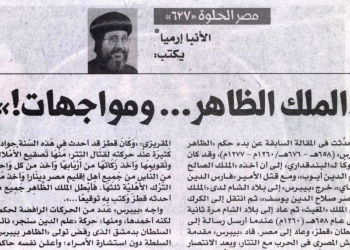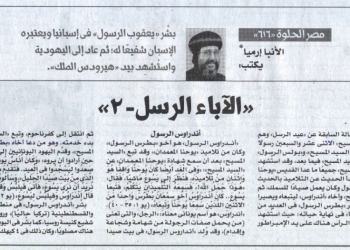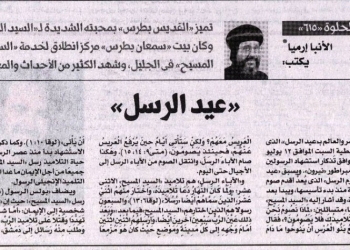Our last article tackled Egyptian man-made Canals dug over the course of history by Egyptians: the canal of Senusret III, Seti I, Nekhau II, work on which washalted due to a premonition by a soothsayer, then completed during the time of Dara / Darius I. Alexander the Great showed some interest in the project of burrowing the canal, which halted at his death, after which the canal of Ptolemy II was dug, then that of Trajan. With the Islamic conquest of Egypt, the canal of Emir of Al-Mu’minin [Believers] was dug, to be neglected later during the Abbasid rule. Along with Napoleon and the French Campaign, studies commenced on the burrowing of the Suez Canal, the idea being cancelled due to erroneous calculations, only to later have the studies resumed.
Second Study on the Burrowing of the Suez Canal
In 1833, a delegation of French engineers arrived to see Mohammed Ali, the governor of Egypt; they were dubbed the “Saint-Simonianists” and were to study the Suez Canal burrowing project. Mohammed Ali Pasha in warmth welcomed them, offering them all aid they needed. Some historians mention that the French presented the canal burrowing project to Ali, who rejected it as presented, the governor of Egypt believing the Egyptian government should fully supervise its implementation and financing, so the canal becomes a purely national project, reaping benefits for the country. He also stipulated that the great nations must guarantee Egypt’s refrain from prejudice, for Mohammed Ali wanted to avoid any foreign interventions in Egypt. Then he established the Qanater Al-Khaireya project around the same time.
In 1835 C.E., many French engineers departed due to the outbreak of the plague that killed a large number of people, all but Ferdinand De Lesseps, who was selected as the Deputy French Consul in Alexandria in 1832 C.E. and the French engineer “Linant de Bellefonds”, both of whom remained in Egypt.
Various historians state that in the year 1840 C.E., a project was drafted whereby a canal was to be dug straight through linking the Red and Mediterranean Seas. It was planned by the French engineer De Bellefonds, who worked in the Egyptian Public Works Department. He tackled in his special report the difference between the water levels of the Red Sea and the Mediterranean Sea, affirming that it would have no negative impact, on the contrary, the difference was to help burrow the canal, offering the River Nile as a specimen of proof for his theory, as its waters pour from the south to the north ending up in the Mediterranean.
Simultaneously, the dream of excavating the canal had not parted with the scientists of “Saint-Simonianists”, thereby moving them to form an association to once more study the project to see whether it was viable. This was in 1846 C.E. This resulted in a new study surfacing in 1847 C.E., in which the French engineer Paulin Talabot affirmed the error of previous calculations, in the claim there’s a difference between the water levels of the Red and Mediterranean Seas. Resulting in his presenting a new report based on information in the previous report by De Bellefonds, emphasizing the possibility of digging the canal without the peril of damage and overflowing of waters over the Delta land. However, the study met with no response due to the illness of Mohammed Ali, and the objections of Britain.
Attempts were renewed to fulfill the dream of burrowing the canal connecting the Red and Mediterranean Seas that was rejected during prior studies, following the assassination of Khedive Abbas I in 1854 C.E., precisely when Said Pasha took office in Egypt, together with the return of Ferdinand De Lesseps to draw near once more, as some historians implied there was a strong bond of friendship between him and Said, as an extension of the friendship between the two fathers, Mathieu De Lesseps, French Envoy of Napoleon Bonaparte to Egypt in 1803 C.E. and its governor Mohammed Ali. De Lesseps managed to utilize his former bond of friendship with Said to convince him of the significance of excavating the canal and its usefulness, until he managed to catch his attention to the project and work on implementing it.
The First Exclusive Contract Decree
In November 1854 C.E., De Lesseps managed to obtain the decree for the initial exclusive contract decree to burrow the Suez Canal. It’s noteworthy that Said Pasha had summoned De Lesseps in a meeting that included a number of the various countries’ consuls, during which he announced his acceptance of the Suez Canal burrowing project, making mention that Mr. Ferdinand De Lesseps had attracted attention to its importance, and its use which will glean great benefits for Egypt, once the Red and Mediterranean Seas are connected, adding that this project will be implemented through a company comprising owners of capital, to be founded and run by De Lesseps. In light of this, Said issued a decree to draft the first exclusive contract for the canal, made up of twelve clauses, most noteworthy: “Mr. Ferdinand De Lesseps will found the company, to be called “The General Suez Canal Company”, and it will be managed by himself, its mission to dig the Suez isthmus, utilizing a path that is suited to heavy maritime activities. The company will also be in charge of establishing two sufficient entrances and equipping them – one overlooking the Red Sea and the other the Mediterranean Sea – and building one or two ports.” The decree also referred to the manager of the company necessarily being hired by the Egyptian government, and that the exclusive rights to running the canal would be granted for a period of 99 years, commencing on the day the canal starts operating, with the stipend that the Egyptian government would be [once the exclusive rights expire] the sole owner of the company and its affiliates, after recompensing the company for its constructions, built to serve the maritime activities of the canal. During that period, the company would submit to Egyptian laws. The Egyptian government would obtain 15% of the net profits, and the company alone would shoulder the costs of the project, in exchange for receiving at no cost all publicly owned land required. Moreover, the company obtained the rights to use all required materials for the canal from public mines and quarries, being exempt from fees that are usually applied on imported tools and materials, noting that the matter of estimating land size was to be left to the French engineer Linant.
Based on the issuing of this decree, De Lesseps, along with the two highest ranking engineers of the Egyptian government, Linant De Bellefonds and Mougel, paid a visit to the Suez isthmus site, to estimate the feasibility of burrowing the canal, in January 1855 C.E. At the time, their report proved the possibility of executing the project and digging the canal. However, De Lesseps formed an international engineering committee to visit the area aiming to study the engineers’ report. The committee’s study confirmed the report that the possibility of digging was viable, and the two Seas were of one even level, and there was no fear of the mud of the River Nile, as the shore of Port Said was sandy; this was towards the end of 1855 C.E.
The study of the trial burrowing had announced that 2613 million square feet of soil ought to be removed, at a cost of 200 million francs, which led to the company facing some problems in obtaining the financing required for the project. This led Said Pasha to buy out 44% of the company, so it could continue to operate.
The Second Exclusive Contract Decree
At the turn of the year 1856 C.E., a decree was issued granting the company a second exclusive right contract, amending some aspects of the first one. The second decree demanded: “The company would commit to fulfilling all building and constructions works to establish a sea maritime canal from Suez on the Red Sea, and Port Said on the Mediterranean Sea, with an irrigation canal suited to river maritime activities connecting the River to the sea canal. It would have two branches for irrigation and drinking, and a harbor for ships would be built at the entrance to the sea canal in each of Port Said and Suez, the volume of Egyptian labor in the burrowing operation would be four fifths [4/5] of the total works. The company also obtained the rights to request an extension of the exclusivity for a second 99 years, up to several periods, with ownership of the Nile waters, and waters of the sweet pond from Cairo feeding into the canal area. It can be sold to Egyptians who benefit from the irrigation operations.”
During the period from 5th November to 30th November, 1858 C.E., stocks started trade in the Suez Canal, thus forming the company and its Board.
Excavation of the Canal Commences
The Canal project was subjected to several attempts by the British and Turks to delay its commencement, because they felt concerned about the risk to their own interests if it were to be accomplished. Till Napoleon III intervened and the actual burrowing started on 25th April, 1859 C.E. at the Port Said point. The Egyptian government had prepared around 27 thousand laborers with no pay for the task! Work continued until the first phase of digging was completed in 1862 C.E.
In 1863 C.E., as Ismail took office in Egypt, work on the project halted once more, making De Lesseps again resort to Napoleon III, such that an international committee was formed in 1864 C.E. to tackle any problems arising in the project. Indeed, all issues were resolved, until the project was completed on the 17th of November, 1869 C.E., when the barrier at Suez was removed, and the waters of the two Seas, Red and Mediterranean mingled, inaugurating the Suez Canal for sea maritime activities before the world. Yet, this task would never have been fulfilled, except at the hands of Egyptians who paid the ultimate price in blood and lives… of spectacular Egypt, words never end… !


 العربية
العربية











